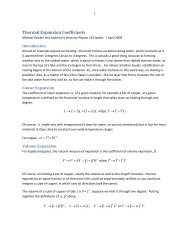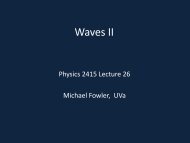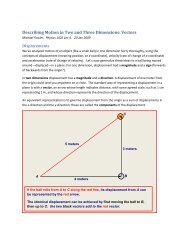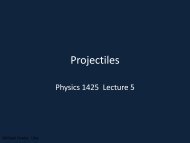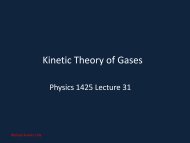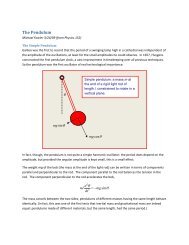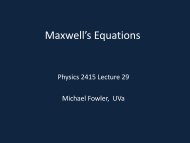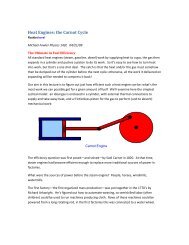Class Notes on Rotational Motion - Galileo and Einstein
Class Notes on Rotational Motion - Galileo and Einstein
Class Notes on Rotational Motion - Galileo and Einstein
Create successful ePaper yourself
Turn your PDF publications into a flip-book with our unique Google optimized e-Paper software.
12Varying Moment of InertiaNewt<strong>on</strong> did not actually write his Sec<strong>on</strong>d Law as F = ma = mdv/dt, but as F = dp/dt, where p = mv iscalled the momentum, <strong>and</strong> in fact this is the correct descripti<strong>on</strong> of nature in cases where the mass of anobject varies, such as a rocket expelling fuel, or a falling raindrop growing from c<strong>on</strong>densati<strong>on</strong>.Similarly, the rotati<strong>on</strong>al Sec<strong>on</strong>d Law = Icould be written more generally asddtto allow for the possibility of a varying moment of inertia, <strong>and</strong> this is much more comm<strong>on</strong> than a varyingmass. Think of a spinning dancer or skater throwing her arms out <strong>and</strong> bringing them in, or of a divercurling up <strong>and</strong> uncurling his rotating body. The external torques are pretty small under these c<strong>on</strong>diti<strong>on</strong>s,the variati<strong>on</strong> in spin speed is largely due to the changing moment of inertia <strong>and</strong> the c<strong>on</strong>stancy of thetotal angular momentum IThe observed variati<strong>on</strong>s in angular velocity c<strong>on</strong>firm the validity of the moregeneral law.Rotati<strong>on</strong>al Kinetic EnergyA rotating object has kinetic energy even if its center of mass is at rest. Think of it as composed of manysmall masses m i at distances r i from the center of mass.Then if the angular velocity is m i has speed v i = r i , <strong>and</strong> kinetic energy ½ m i r i 2 2 , <strong>and</strong> summing these,If a net torque is acting, this energy will change:ddtI KE of rotati<strong>on</strong> = ½ I 2 .d dt1 22I I Iso the rate of working, the power, of a torque equals the magnitude of the torque multiplied by theangular velocity, just as a force F moving something at speed v is working at a rate Fv.This equati<strong>on</strong> can also be integrated:dd I dt dt ddt1 22 The total change in kinetic energy equals the integral of torque times angular distance, valid even if thetorque is varying.Rolling Down a RampFor example, we’ll take the case of a hoop of radius R rolling down a ramp without slipping. Suppose atsome instant the center of the hoop is moving with speed v. Of course, other points <strong>on</strong> the hoop are




